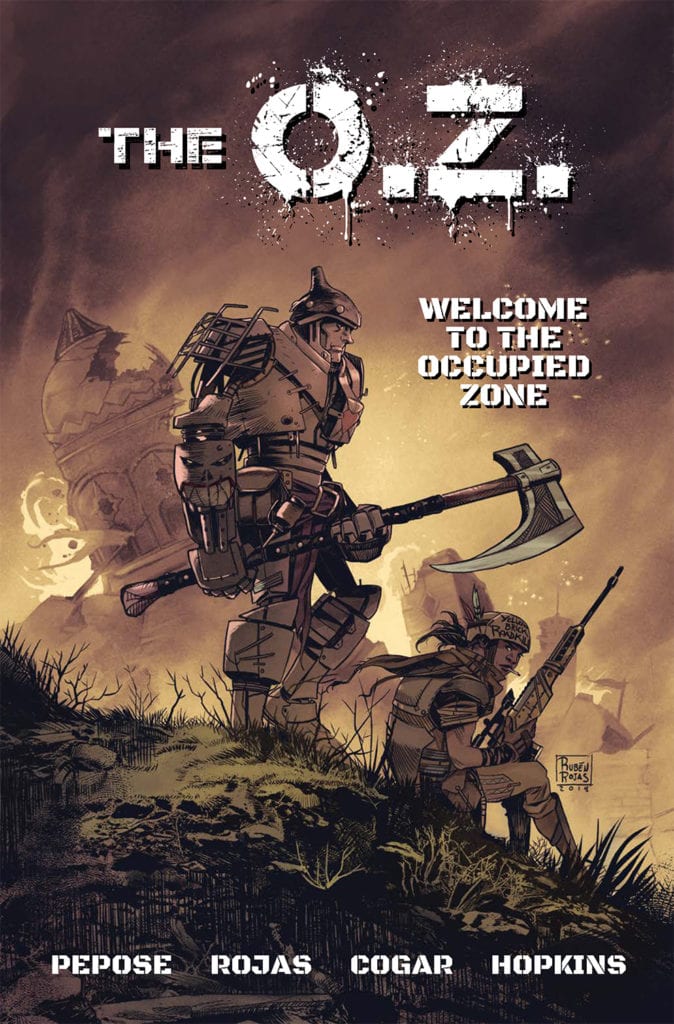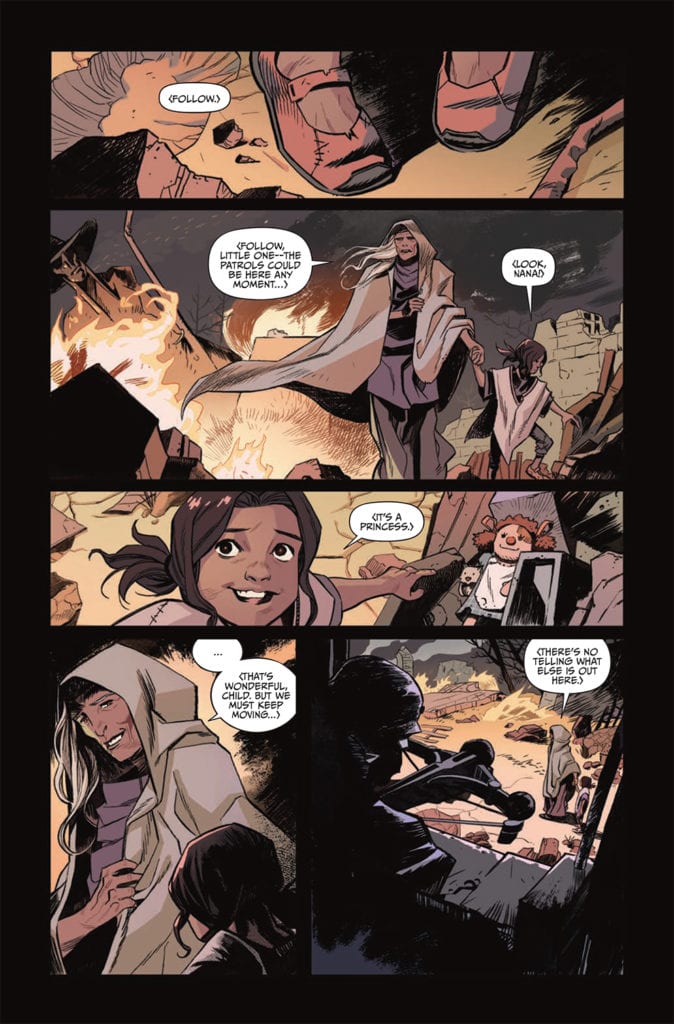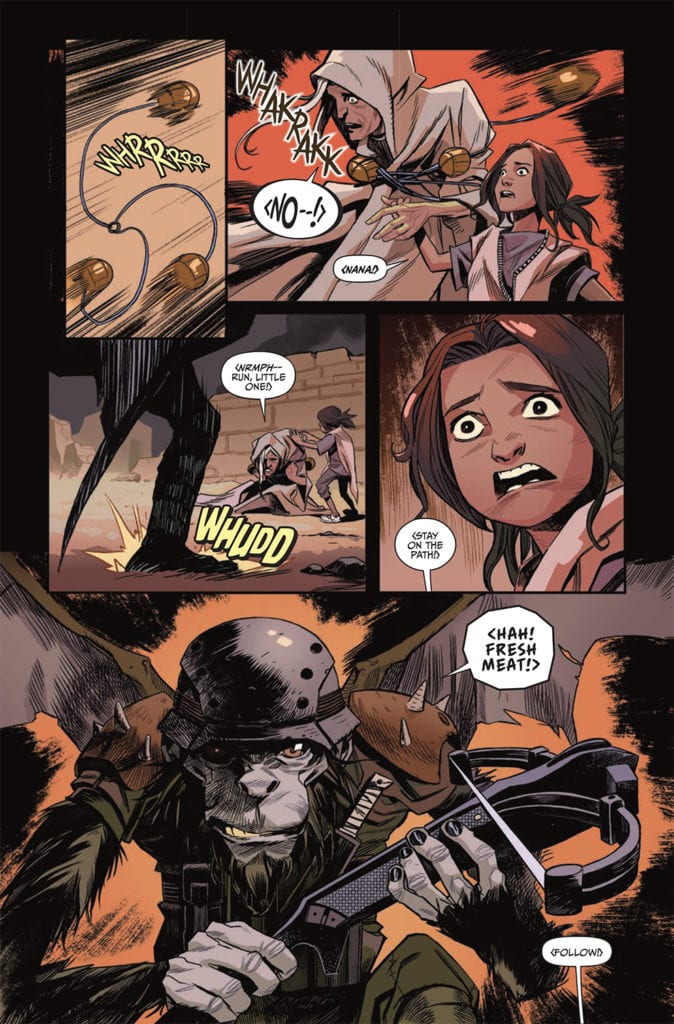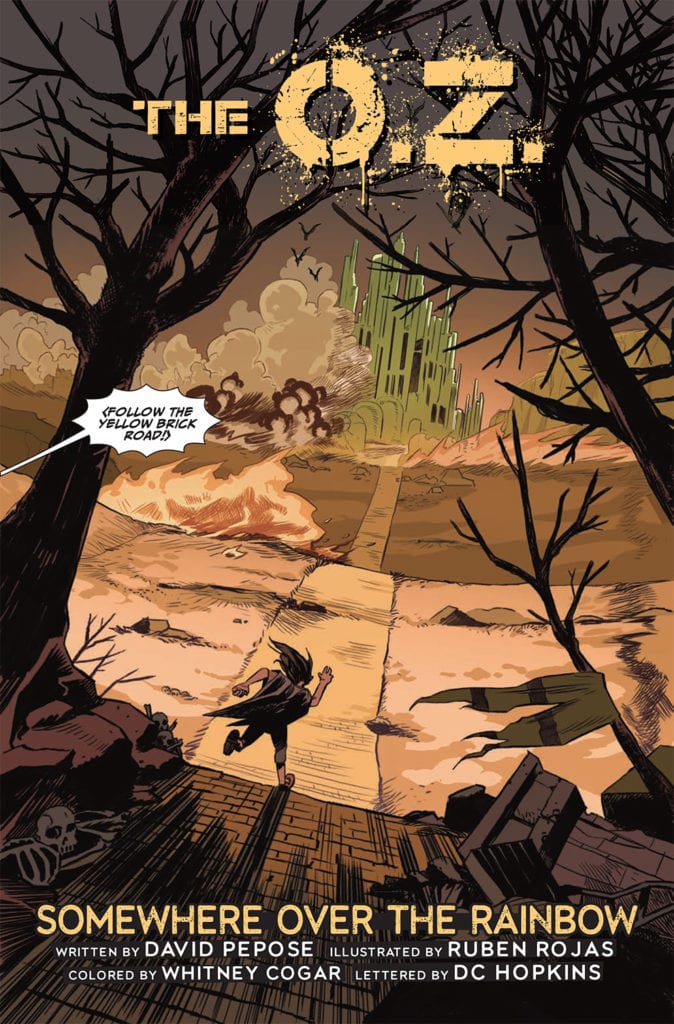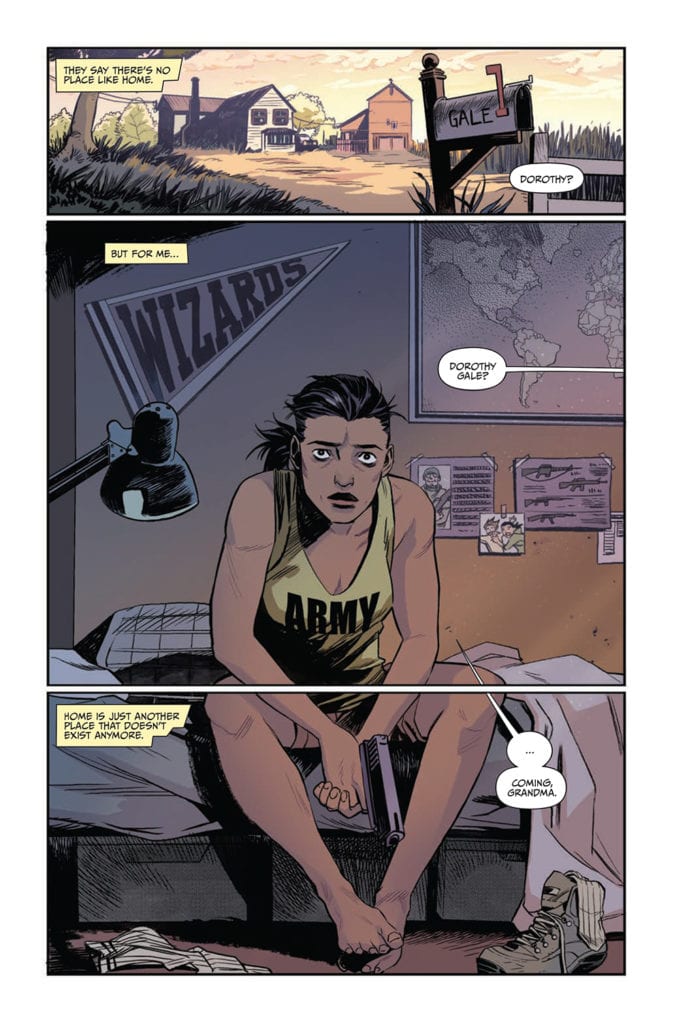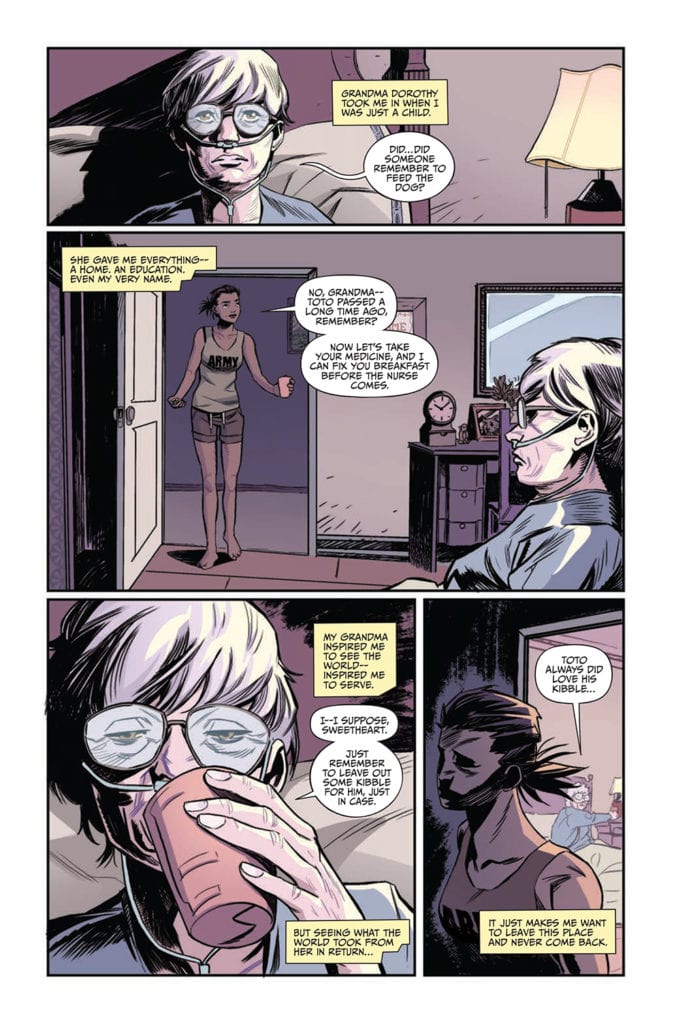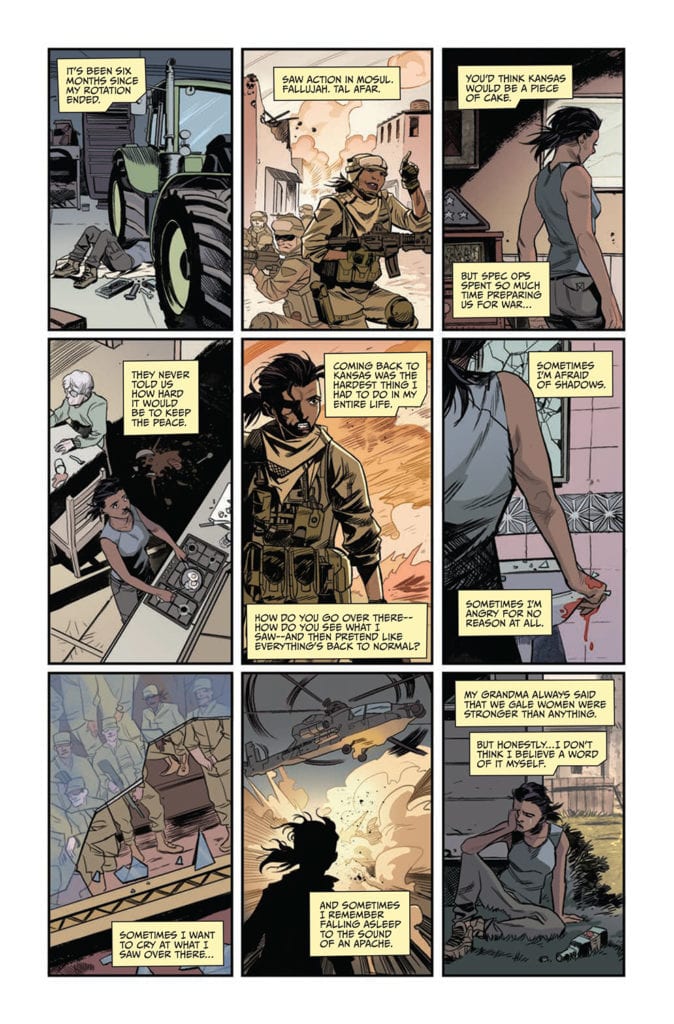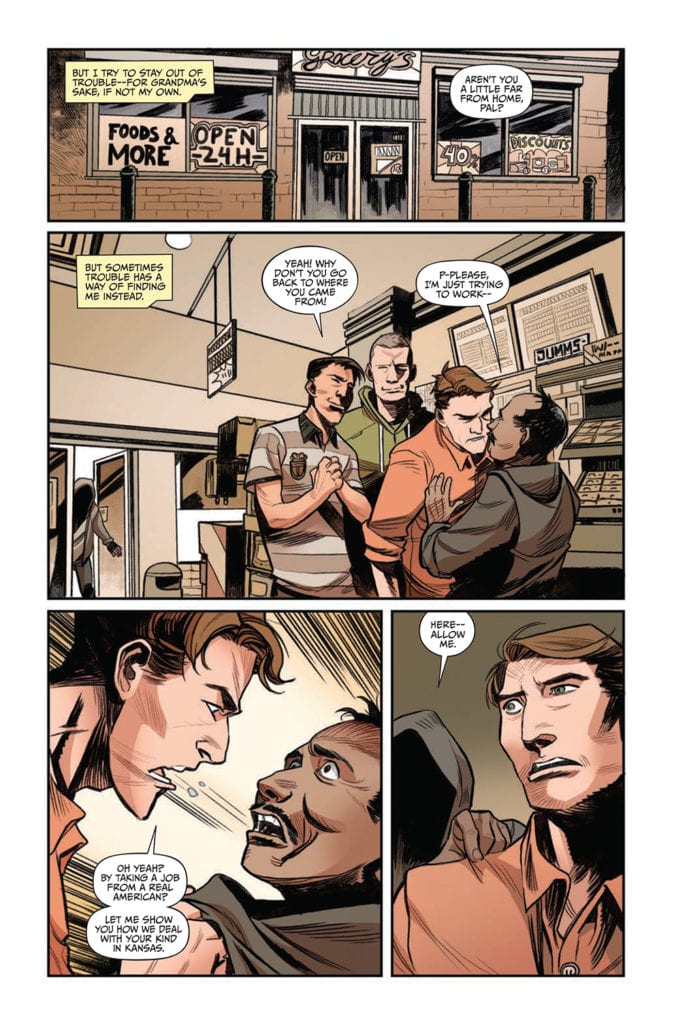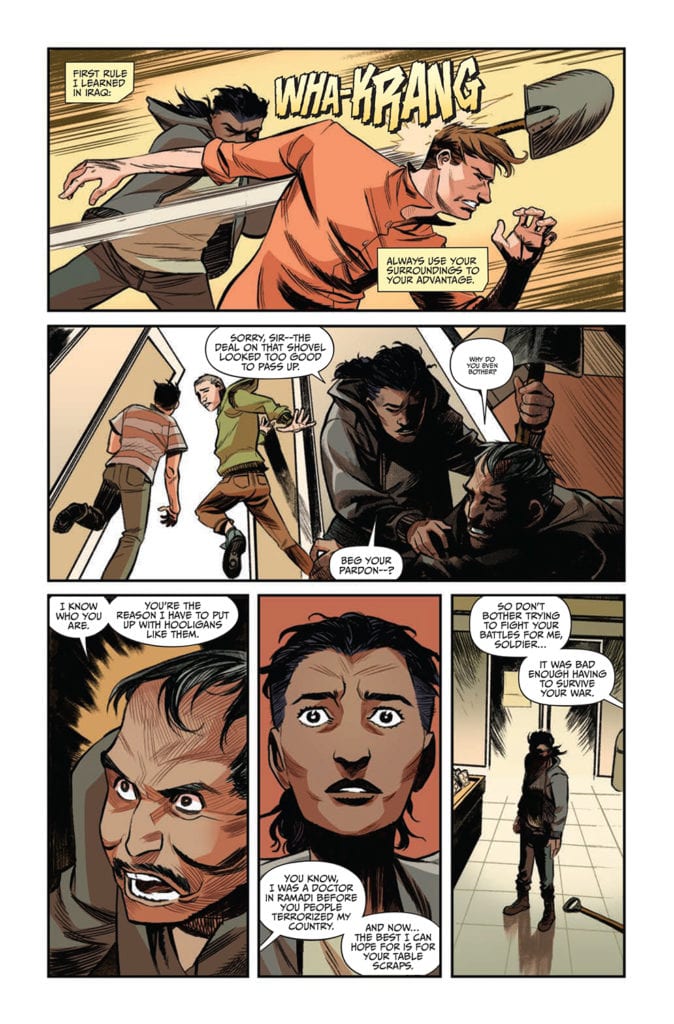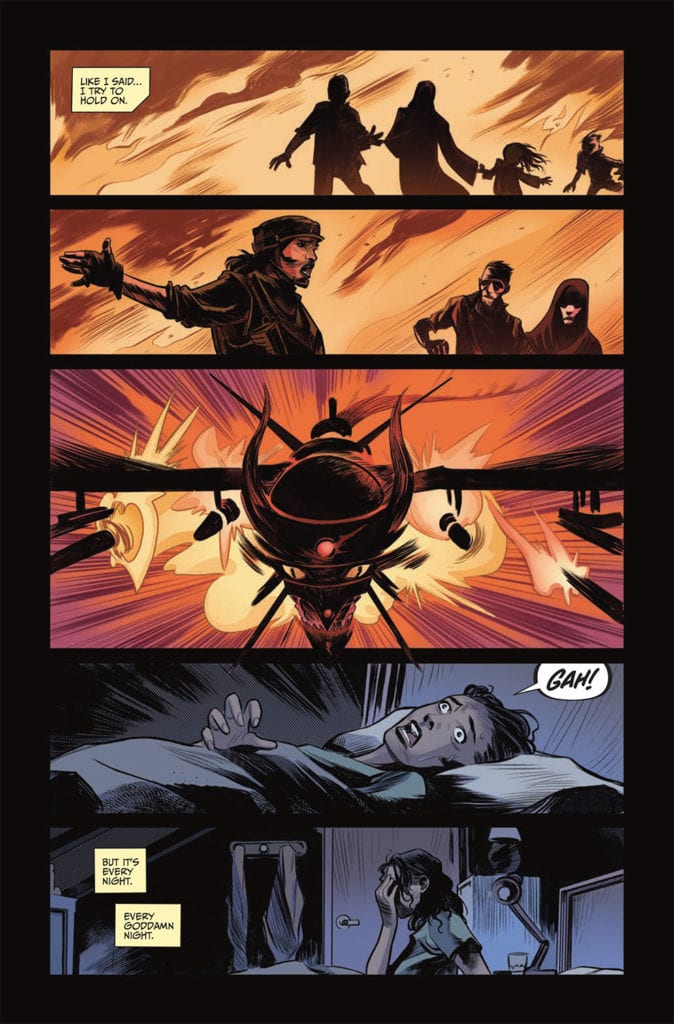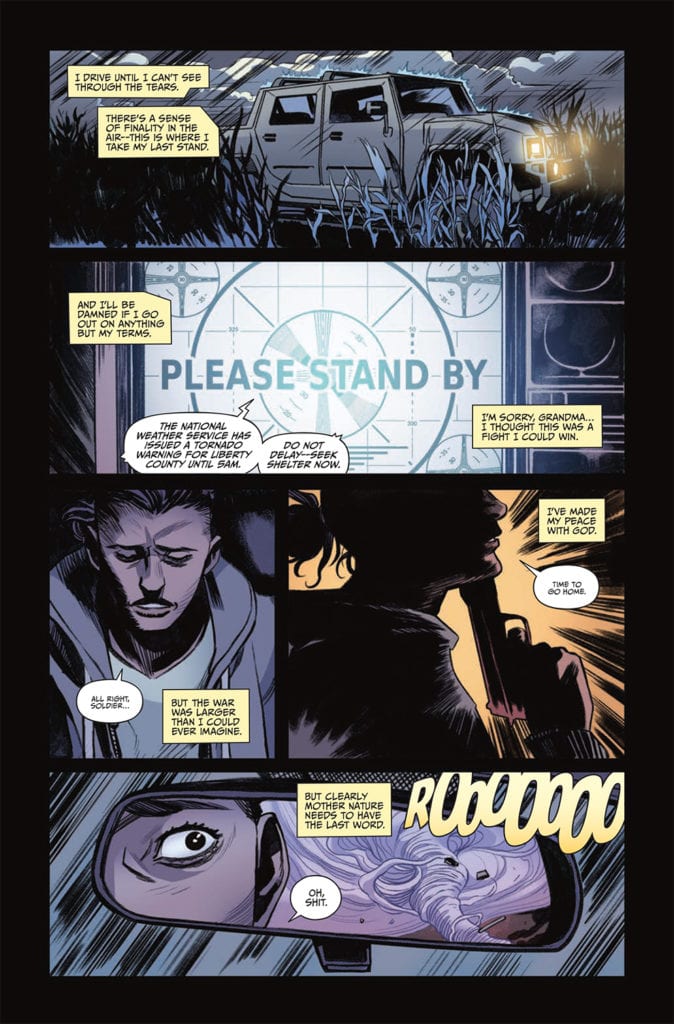THE O.Z. is a new project on Kickstarter written by David Pepose, and it’s a take on The Wizard of Oz like you’ve never seen before. We spoke with Pepose about the genesis of the series, and why crowdfunding was the best platform for the book.
About the series:
You remember The Wizard of Oz, right? Remember how Dorothy and her friends vanquished the Wicked Witch of the West and everyone lived happily ever after? Well it turns out the resulting power vacuum sent Oz spiraling into decades of civil war. Now, Dorothy’s Iraq War veteran granddaughter has to try and bring peace to the magical land. Forget not being in Kansas anymore, we’re not even in Oz. This is the Occupied Zone. This is THE O.Z.
THE O.Z. is currently funding on Kickstarter, as mentioned, and you can check out the project by clicking here. This is the first of what the team is planning to be three double-sized Kickstarter campaigns for the comic. David has co-created the series with artist Ruben Rojas, colorist Whitney Cogar, and letterer DC Hopkins.
Check out the first 11 pages of THE O.Z. right here:
And read on for our full interview with David Pepose:
Monkeys Fighting Robots: First, you put Calvin and Hobbes in Sin City. Now, you’re throwing the wonderful land of Oz into civil war. I have to ask: Why do you insist on killing our childhood memories? What draws you to these gritty reimaginings?
David Pepose: You know, I swear I didn’t go into this business to be a serial childhood ruiner! (Laughs) But I think remixing and reimagining has been part of the comics industry from the creation of Barry Allen and the Teenage Mutant Ninja Turtles to Mark Russell’s spin on Snagglepuss, Tom King’s take on Elmer Fudd, to the current zeitgeist around Riverdale. There’s something about taking the familiar and reinventing it with a brand-new angle and tone that’s really appealing to me.
For me, with books like Spencer & Locke and now The O.Z., is that nostalgia in certain ways is almost like a shared history we all share — it’s a vision of the world before it became so complicated. And the great thing about universal archetypes like The Wizard of Oz is that they’re so flexible — I think it allows creators like myself to take a deeper dive into more morally complex territory, because nothing will ever break these symbols. And I think that lets readers follow these characters’ journeys with more confidence — they know that if these characters can survive and find their own meaning and direction, maybe our readers can, too.
MFR: What’s been going on in Oz since audiences have last visited?
Pepose: Unless you’ve been living under a rock, most people know the story of The Wizard of Oz — Dorothy Gale is swept up by a hurricane, drops into Oz, makes three extraordinary friends, and winds up killing the Wicked Witch of the West. And then… she goes back home. Which is great for Dorothy, but I felt would be a recipe for complete disaster for the land of Oz.
When you put it down on paper, the original Wizard of Oz story honestly reminded me of the invasion of Iraq — it’s easy to get wrapped up in black-and-white thinking about taking down despots, but as we’ve seen, regime change is harder than it looks, even when there’s an actual plan in place. Without committed infrastructure and planning, what’s to stop the land of Oz from falling into a horrific power vacuum, or devolve into decades of civil war?
And that’s where the story of The O.Z. begins, a generation after Dorothy defeated the Wicked Witch and then split. Life in the Occupied Zone has been brutal, and Dorothy’s former friends like the Tin Soldier, the Scarecrow, and the Courageous Lion have each taken their own path trying to regain some semblance of order. But like people a lot smarter than me have said, war is hell, and this battlefield is only going to escalate once someone else from Kansas arrives… namely, Dorothy Gale’s granddaughter, a disillusioned Iraq war veteran.
MFR: And what can you tell us about this new Dorothy? Who is she, and what sets her apart from her grandmother, the Dorothy fans know from the original Wizard of Oz?
Pepose: Our new Dorothy is the granddaughter of the original — but whereas the original Dorothy was about as sweet and wholesome as you might expect, our new Dorothy has endured some pretty hard-earned experience. She served in the Army in Iraq and Afghanistan, and she’s come back to Liberty, Kansas to care for her ailing grandmother, while struggling to find any sense of purpose and direction.
The thing I’ve always tried to impart with my books is that even if the high concepts might be shocking or subversive to some degree, I’m never doing this for the sake of shock value. Shock value can get readers interested once — but that’s not going to keep readers invested for a second round. In particular, because I began developing this story at the same time as the military-oriented Spencer & Locke 2, I wanted to give Dorothy a really deep emotional core as a soldier and a survivor, and establish some bigger moral stakes beyond just blowing stuff up.
The O.Z. is the story of a soldier who already has serious misgivings about the utility and morality of war in the first place — and now, by virtue of her heritage, Dorothy’s going to be thrust into a leadership position that could decide the fate of millions. It’s a lot to carry on her shoulders — she’s got to grapple with trauma, with guilt, and the moral calculus you’ve got to perform on the fly when you know that every decision you make is likely to wind up with someone dead. It’s almost like the Hippocratic Oath — how do you do no harm, or perhaps the least amount of harm, when you’re trained to kill and there are enemies in sight?
Of course, there’s just as much Star Wars to this book as there is Mad Max or The Hurt Locker, and so Dorothy’s training will affect a lot of what happens in The O.Z. There’s that phrase if all you have is a hammer, every problem looks like a nail…? In this case, Dorothy’s a trained soldier, and she’s been dropped into a war, and part of the sparks that fly off this book will be how she brings her unique training and translates it through this dangerous, magical world.
MFR: You’re working with Ruben Rojas, Whitney Cogar, and DC Hopkins on this book. How did they react when you first pitched them the idea?
Pepose: I’ve known Ruben since 2018, seeing him post his portfolio in response to a call for artists on Twitter. (I was, and continue to be, gobsmacked that he wasn’t scooped up on the spot.) So I actually pitched him on a trio of stories — the first being my then-unannounced series Grand Theft Astro, the second being The O.Z., and the third being another concept that’s currently on the backburner. Ruben immediately gravitated towards this one, and after taking some time to finally iron out the scheduling amidst both of our workloads, we got our initial pitch pages together later in 2019 — and I was so blown away I immediately told him, “let’s do more.��
Credit where credit is due — I owe Mad Cave editor Michael Moccio for recommending Whitney and DC. I’ve known Michael for the better part of a decade, and he had been singing Dave Hopkins’ praises for ages — Dave and I wound up crossing paths at Denver Comic Con a year or so back, and we just immediately hit it off. He’s a super-sweet guy, incredibly good-natured, and an absolute dream to work with — which is great when I need to micromanage my dialogue so it fits in the actual artwork, haha.
Whitney was the final piece of the puzzle, and again, Mike absolutely knew what I was looking for — he had worked with Whitney during his time at BOOM! Studios, and just raved about her. After seeing her pages hit my inbox, I can absolutely say Whitney exceeded the hype — she’s been our secret weapon from the beginning, taking Ruben’s already exemplary work and just bringing it to an incredible new level. But that’s the best thing about the creative team for The O.Z. — any one of them on their own are superstars. But when you put them together, they create something truly magical.
MFR: What was the design process like for this book? How did you all find a way to update such iconic settings and characters while keeping true to their iconic roots?
Pepose: Working with Ruben has been such a blast, and pretty much every time I’ve seen him turn in pages I’ve just started cackling with glee. Ruben is one of the most talented and gifted artists I’ve ever had the fortune of working with — he just goes so far above and beyond with his design work, and he’s an incredible collaborator in the truest sense of the word.
As I’ve gotten my feet under me more as a writer, I’ve been more experimental in terms of finding reference for Ruben, and he incorporates it magnificently — his design on the Tin Soldier, for example, is absolutely breathtaking, as this hulking war machine who’s been blown up and put back together so many times you can hardly recognize him. Dorothy, on the other hand, has that soldier’s eye, a lot of makeshift combat armor with some flourishes ranging from Vietnam-style helmet graffiti to a bit of a Western-style cloak.
For the Scarecrow, meanwhile, we focused on his physicality and body language — asking ourselves what a man made of straw might look like after all these years, almost like a deflated balloon. And the Courageous Lion has been a particularly fun challenge, because we get to tackle themes ranging from legacy to the challenges of someone who wears a crown.
I will say, without spoiling too much, Ruben’s take on The Wizard of Oz is stupendously good. When fans see him, they are going to lose their minds. I know I did.
MFR: How did you and Cogar settle on the color palette for this book? Oz has such a legendary bright and colorful look, but obviously for a war story like THE O.Z. you want something a little different.
Pepose: For those who don’t know my previous works, I am a tremendous color snob. (Laughs) I got my start as an intern at DC Comics, and they really instilled in me how important color is to any comic — the right colorist can elevate any artwork, but the wrong colorist is just the kiss of death. So I’m very exacting with how our colors interact with our line art… and boy, did Whitney just go above and beyond any expectations that I’ve had. (Which makes plenty of sense, given that she’s worked on Giant Days, which, y’know, won an Eisner.)
When Whitney and I first discussed The O.Z., I asked her to imagine Star Wars with a Mad Max kind of bent — I firmly maintain that Star Wars has such immense longevity because of the sheer scale of the worldbuilding. Every setting has its own palette, its own color temperature, its own vibe and flavor — you can immediately imagine the desert of Tatooine, the icy tundra of Hoth, the forests of Endor, or sterile machinery of the Death Star. (Even the volcano where Anakin Skywalker burned is memorable, for a prequel that most people don’t even enjoy!)
That expansiveness was a quality I really wanted to have in The O.Z., because obviously the cornfields of Kansas are going to have a very different vibe than, say, the bombed-out Emerald City where the Resistance hides, or the ominous yellows of the Deadly Desert, or the otherworldly eldritch teals of the Wicked Witch’s cauldron. And what’s most impressive to me is how quickly Whitney got it — like I said, I’m pretty exacting with my colors, about what feels right and what doesn’t, but Whitney just knocks it out of the park every time. I know Ruben and I both feel incredibly fortunate and grateful to be working with her.
MFR: Why take THE O.Z. to Kickstarter? Was it purely due to the current COVID-driven market conditions, or were other factors at play?
Pepose: I’d say a little of Column A, a little of Column B. The O.Z. has been a book I’ve been working on for years — dating back to the release of the first volume of Spencer & Locke. But like Spencer & Locke and Going to the Chapel, sometimes it’s challenging to get a publisher at the right place, at the right time, in the right frame of mind — and in particular, when you’re an up-and-coming writer with a brand-new artist, it’s challenging to get a publisher to bite on what had been planned as a six-issue miniseries. You add covid to the mix — with some publishers throttling new acquisitions until 2022 — and you realize shifting strategies is a good thing.
But the thing is, I’ve been eying Kickstarter for a long time. Some of my closest friends in the industry — Charlie Stickney of White Ash fame, The Jump writer Rylend Grant, Frank Gogol’s breakout work Grief, Russell Nohelty’s sprawling body of work — have all found major success on Kickstarter, and they’ve been press-ganging me for close to a year to get me to take the plunge. Because there really are different markets out there — some people only buy books at comic shops, others only buy on Amazon, others only buy at cons, and others only buy on Kickstarter.
I’ve always believed in bringing as many people to the table as possible, in making my stories accessible and building a wider consensus of fans — so I think taking the plunge on Kickstarter was always going to be inevitable, just to build on the amazing audience we’ve had with Spencer & Locke and Going to the Chapel. But launching this Kickstarter during the unpredictability of covid also meant we didn’t have to wait for a publisher’s permission to create anymore — because as I’ve seen Ruben, Whitney and DC’s pages coming in over the last year or so, I knew it would be downright criminal to keep this book hidden under wraps any longer.
MFR: Did you approach this project any differently than your previous works? Do you find the Kickstarter element any more freeing or restrictive on your writing?
Pepose: The O.Z. has been a very different animal as far as the writing and production process has gone, and I think that process ultimately is what also made me feel more comfortable with taking the plunge on Kickstarter. For the previous books I’ve pitched, I’ve usually just come up with a small number of pages and an outline detailing the rest of the story — but after talking with friends like Rylend, Frank, and Strayed creator Carlos Giffoni, I realized there was something to be said about barrelling ahead, publisher involvement be damned. Because when you’ve got someone like Ruben working on art, how can you tell him to just keep it to six pages?
So as opposed to Spencer & Locke or Going to the Chapel, which I didn’t script beyond the first issue until a publisher had acquired the book, I actually went full-bore in writing the entire series even without having a company attached. That’s right, The O.Z. is completely written, weighing in at 140 pages across what we plan to be three double-sized Kickstarter campaigns. We’ve currently got the first 44 pages already locked and in the bag, which made me feel a lot better about rolling the dice with self-publishing — I’m confident that Ruben and Whitney can chisel through the series at enough speed to let us roll out our Kickstarters every few months, but still do so at a pace that won’t kill my creative team. Or me. (Laughs)
But this project has definitely been unique, just in terms of the sheer scale I’m working with here — it’s the longest book I’ve written so far, and it’s really sprawling in terms of locations and stakes and the kinds of themes we wanted to work with. It for sure shares some DNA with both Spencer & Locke and Chapel, but I think the fantasy and war genres give The O.Z. its own unique flavor, as do the messages and themes we’re choosing to explore. I think there’s a real sense of responsibility we’re all bringing to the project to bring our A-game and not alienate any of the real-life veterans who might be reading this book.
MFR: How has Kickstarter changed the way you see the comics industry and its distribution system?
Pepose: Covid has really made me rethink about how I’m doing business, and I’d imagine a lot of creators are feeling the same way. For the longest time, I’ve been a con warrior — I think I did something like 16 shows last year? — and obviously, it’s going to be a long time before it’s safe for anyone to do an in-person show again. And you’ve seen even this year, if the country gets hit with stay-at-home orders, even the Diamond system we’ve used as a benchmark for so long can suddenly cause a cascade of ripple effects from publishers all the way to retailers.
For me, focusing on my digital presence has been really important to me — not just promoting my work on Facebook, Twitter, and Instagram, but finding out new ways to present and sell my work online. And covid in a lot of ways has removed any last vestiges of stigma associated with the platform — you’ve got Jeff Lemire and Matt Kindt on the platform, you’ve got Saladin Ahmed, you’ve got people like Jimmy Palmiotti or Cullen Bunn… I’m certainly not abandoning the traditional publisher model, since I have books in the works elsewhere, but the idea of building a following during this time of uncertainty through as many different avenues as possible feels like the only real option moving forward.
MFR: You are one of the hardest working guys in comics when it comes to promoting and marketing your comics. Do you have any advice for creators who are just entering the game and want to get the word out about their projects (or even established creators who struggle with this)?
Pepose: Well, first off, thank you for saying that — I assure you it comes from the bracing fear of not wanting to let down your collaborators or watch your projects crash and burn. (Laughs) But I consider myself lucky — I’ve worked in publicity and the press before, so I know both sides of that equation, and I also have never been afraid of talking a lot. (Laughs)
Still, I remember when I was first starting out on the convention scene, and how awkward I felt promoting my own work — if it’s good enough, shouldn’t it just catch someone’s eye and sell itself? And that’s something I think creators have to work extra-hard to try to overcome — particularly writers, because if you’re the one steering the ship, it’s up to you to get the spotlight for your sake and that of your collaborators. When I’m working with pros like Ruben, Whitney, and DC (or collaborators like Jorge Santiago, Jr., Jasen Smith, Gavin Guidry, Liz Kramer, Colin Bell, or Ariana Maher!), it gets really easy to talk them up, because they’re so incredibly good.
My advice for creators who want to get the word out is to figure out why a stranger would care about your project — this is probably something you want to think about while you’re actually making the project, but it’s never too late to start. (Laughs) Who’s your target audience? Are there any similar titles that operate in the same wheelhouse as your work? Making sure you can actually provide artwork to show is massive — I can’t tell you how many times I’ve almost overlooked a book, and then had some gorgeous artwork hook me right back in.
Beyond that, I think it’s just researching the market, knowing which places will cover comics, and doing your best to establish relationships long-term. You and I have known each other for a few years now, for example, and while I think some of that comes from you genuinely enjoying and supporting my books — which, y’know, thank you again for that! — but I think that friendship started just by me emailing you like an actual human being, rather than a form letter.
MFR: What are you most excited about with THE O.Z.? What are you most looking forward to fans seeing?
Pepose: There’s so much I’m excited about, seriously — our variant covers from Maan House, Rio Burton, and Kenneth Wagnon, for starters. Or seeing what people think of Dorothy, the Tin Soldier, and the Wizard of Oz. Or just hitting and surpassing our Kickstarter goal! (Laughs)
Honestly, the thing I’m most excited about with The O.Z. is that it takes some of the building blocks of my previous work and blows them up in a major way, but never at the cost of our artistic integrity. Every creator wants to keep growing with their work, and I’m really proud of the ambition and scale we’ve got here. I can safely say this book looks and reads every bit as good as I could have possibly hoped — I certainly think it’s the best-written book I’ve done yet, and I think anyone with eyes would agree it’s amongst the best-looking books I’ve ever worked on.
The thing I’m always excited for is to see fan expectations get turned on their heads — like I said, I think everyone has an idea of what The Wizard of Oz looks like in their minds, and The O.Z. definitely is going to upend that in a big way. This is an action-packed adventure on the other side of the rainbow, one that I think brings its own brand of brains, heart, and courage to the table. You may think you know the story of Oz, but this is the story of what comes next, so I hope fans of Mad Max, The Old Guard, and Fables join us in the trenches for The O.Z.
Thanks again to David Pepose for taking the time to talk with us. You can follow David on Twitter here, and check out THE O.Z. on Kickstarter right here.


